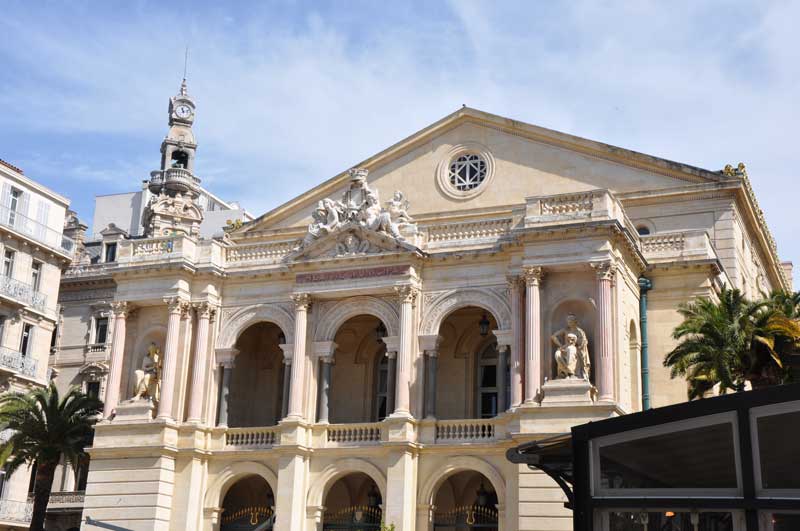
Located in Toulon, the third-largest French city on the Mediterranean coast, the Toulon Opera, locally known as L'opéra de Toulon, is the second-largest opera house in France, after the Palais Garnier, located at the Place de l'Opéra, opened thirteen years after the opening of L'opéra de Toulon. Construction of the new opera house was made possible by the extension of the city decreed in 1853 and the transfer of its ramparts further north and it replaced the old fashioned Salle de la Comédie, which was cramped and uncomfortable, according to the good society of Toulouse. The neo-classical building with its semicircular arches, grey and pink columns, representing the exuberant style of the Second Empire, also known as the Napoleon III style, is one of the outstanding buildings in the series of opera houses, which were constructed in France, along with other European countries in the middle of the 19th century.

Designed by Léon Feuchéres, who built the opera house in Avignon, destroyed in a fire on 26 January 1846 and renovated the Marseille Opera, the construction of the Toulon Opera building began on 5 March 1860, two years before the start of construction of the Palais Garnier. But unfortunately, as Léon Feuchéres died in 1860, before the completion of the building, the work was finished by Paris architects Charpentier, pére et fils. However, the 49 feet (15 m) canvas on the ceiling was painted and its plaster ornament was designed by the French painter Louis Duveau, who also created the ceiling of the Grand Salon of the Imperial Apartments in the Napoleon Wing of the Louvre in Paris. Finally, the new opera house was inaugurated on 1 October 1862, with Les Mousquetaires de la reine, a comic opera by Fromental Halévy, a French composer, which was followed Halévy's most famous opera, La Juive. Currently, L'opéra de Toulon is the home of the Opéra Toulon Provence Méditerranée, which performs about eight operas a season in the opera houses of Toulon, Nice and Avignon.

Regarded as the first monument erected in the new Toulon and located in the heart of the new city, whose area has become multiplied by three, the imposing building of the Grand Théâtre, L'opéra de Toulon is one of the most important provincial opera houses in the country. It is oriented North-South, with a grand façade to the south, cleared by a square fitted out from the outset for this purpose along Rue Royale, renamed Rue Jean Jaurès and an equally majestic façade to the north, remarkably adorning the brand new Boulevard Louis-Napoléon. The north façade of the building is aesthetically decorated with six statues created by the Toulon sculptor Pierre Marius Montagne, which include from left to right the six muses, namely Euterpe, the muse of song and poetry; Terpsichore, the muse of dance and choral music; Melpomene, the muse of tragedy; Thalia, the muse of comedy; Calliope, the muse of history and Polyhymnia, the muse of religious hymns.

L'opéra de Toulon, built with a capacity of 1787 seats and about 74 wide and 39 feet wide stage, represents an example of neoclassical architecture and occupies a floor area of around 21527 sq feet (2000 sq m). The building is highlighted by the use of the natural slope of the land, making it possible to create a large staircase to the south, which releases it from the square in a spectacular way, resembling the forecourt of a cathedral or rather a Greek temple, complete with columns, pediment and several statues of Apollo. Added to it, the building also has many more interesting details, among which the most noteworthy are the geometric friezes of Byzantine inspiration.

It was mentioned earlier that L'opéra de Toulon is the home of the Opéra Toulon Provence Méditerranée opera company. The reputed music directors, who served the company in the past, include among others, Giuliano Carella (2003-2018) and Jurjen Hempel (2018-2021). In the recent past, the company announced in June 2021, the appointments of Marzena Diakun and Valerio Galli as co-principal conductors of the company, effective 1 September 2021.

It is interesting to know that, the spectacular building of the opera house served as the setting for the 1967 French horror film La malédiction de Belphégor (also known as The Curse of Belphegor ).